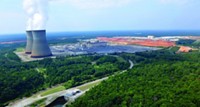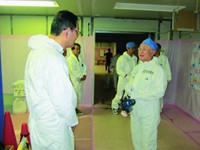Advertisement
Grab your lab coat. Let's get started
Welcome!
Welcome!
Create an account below to get 6 C&EN articles per month, receive newsletters and more - all free.
It seems this is your first time logging in online. Please enter the following information to continue.
As an ACS member you automatically get access to this site. All we need is few more details to create your reading experience.
Not you? Sign in with a different account.
Not you? Sign in with a different account.
ERROR 1
ERROR 1
ERROR 2
ERROR 2
ERROR 2
ERROR 2
ERROR 2
Password and Confirm password must match.
If you have an ACS member number, please enter it here so we can link this account to your membership. (optional)
ERROR 2
ACS values your privacy. By submitting your information, you are gaining access to C&EN and subscribing to our weekly newsletter. We use the information you provide to make your reading experience better, and we will never sell your data to third party members.
Safety
U.S. Reactors Deemed Safe
Nuclear Power: Commission says emergency preparedness still needs improvement
by Glenn Hess
August 4, 2011
Federal regulators are confident that U.S. nuclear power plants are operating safely, but changes are needed to make sure the facilities are better prepared to deal with natural disasters that simultaneously impact multiple reactors, officials testified at a June 16 Senate hearing.
Nuclear Regulatory Commission (NRC) Chairman Gregory B. Jaczko told the Senate Environment & Public Works Committee that the likelihood of a Fukushima Daiichi-type event occurring in the U.S. is “very, very small.” But, he said, some lessons have already been learned from the Japanese nuclear crisis.
At present, emergency plans for most U.S. nuclear reactors envision a single incident putting one reactor in danger. But at Fukushima, all four operating reactors were damaged by the massive tsunami that followed a magnitude-9 earthquake in March.
“Clearly Fukushima-Daiichi showed us that we have to consider the possibility of multiple units at a single site, perhaps multiple spent fuel pools being affected at the same time,” Jaczko said.
An NRC task force is in the middle of a 90-day review of U.S. nuclear reactor safety, searching for lessons from the Fukushima incident that can quickly be applied. The 90-day study, to be released on July 19, will be followed by a more in-depth analysis that could lead to far-reaching changes at U.S. plants.
“Since Japan’s nuclear disaster began unfolding, Americans have asked, with a good deal of trepidation: could it happen here? Nothing can be taken for granted where nuclear power is concerned,” said Sen. Frank R. Lautenberg (D-N.J.). “Japan, a world leader in technology, believed the Fukushima plant was strong enough to withstand a worst-case scenario. And now we know it was not.”
NRC Commissioner George Apostolakis said the nuclear incident in Japan is a “lesson in humility” for regulators. “I believe that, as a community of safety analysts, we were pretty confident that there would be no new surprises,” Apostolakis said. “Fukushima has challenged that belief.”
Last month, NRC said its initial inspections had found problems with equipment, training, and procedures at some nuclear facilities, but none of the issues posed a significant safety risk. (C&EN, May 23, page 19).
Meanwhile, the U.N.’s International Atomic Energy Agency (IAEA) is calling for national safety tests on all the world’s nuclear reactors within 18 months to avoid a repeat of Japan’s nuclear crisis. The safety tests would be followed by random international inspections.
“IAEA review of every one of the world’s 440 operating nuclear reactors in just a few years is not a realistic proposition. I therefore propose a system based on random selection,” said IAEA Director General Yukiya Amano on June 20 at a ministerial-level meeting in Vienna of the U.N. body’s 151 member states.





Join the conversation
Contact the reporter
Submit a Letter to the Editor for publication
Engage with us on Twitter